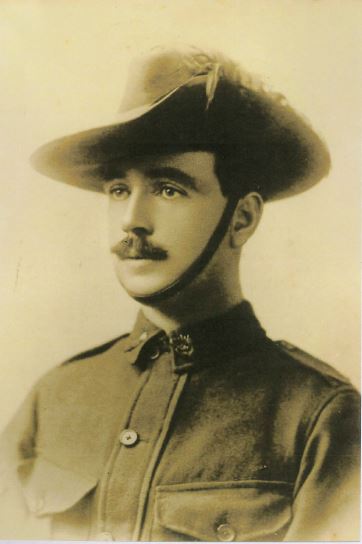Dvr
Frederick Ernest Carter
Informatie over geboorte
|
Geboortejaar: 1891 |
|
Geboorteplaats: Hull, Kingston upon Hull, Engeland, Verenigd Koninkrijk |
Algemene Informatie
|
Beroep: Stoker |
Informatie legerdienst
|
Land: Australië |
|
Strijdmacht: Australian Imperial Force |
|
Rang: Driver |
|
Service nummer: 899 |
|
Dienstneming datum: 29/12/1914 |
|
Dienstneming plaats: Enoggera, Queensland, Australië |
|
Eenheden: — Australian Field Artillery, 49th Bty. 13th Bde. (Laatst gekende eenheid) |
Informatie over overlijden
|
Datum van overlijden: 19/08/1917 |
|
Plaats van overlijden: Vlamertinge, België |
|
Doodsoorzaak: Died of wounds (D.O.W.) |
|
Leeftijd: 26 |
Begraafplaats
|
Vlamertinghe New Military Cemetery Plot: 8 Rij: F Graf: 15 |
Onderscheidingen en medailles 3
|
1914-15 Star Medaille |
|
British War Medal Medaille |
|
Victory Medal Medaille |
Points of interest 3
| #1 | Geboorteplaats | ||
| #2 | Dienstneming plaats | ||
| #3 | Plaats van overlijden (bij benadering) |
Mijn verhaal
In the night of the 13th and 14th of August 1917 the 13th Australian Field Artillery Brigade of the 5th Australian Division was ordered to move to forward positions near the hamlet of Potijze, about one mile Northeast of the city of Ypres. The 13th Australian Field Artillery Brigade moved a total of nine guns to the forward positions East of Potijze. Two guns of the Australian Field Artillery 49th Battery, two guns of the 50th Battery, three guns of the 51st and two guns of the 113th Howitzer Battery.
The 13th Australian Field Artillery Brigade would assist the attack of the 16th (Irish) Division on the 16th of August 1917. The 16th Division attacked on the 16th of August 1917, the first day of the Battle of Langemarck, from their positions on the Frezenberg Ridge towards the German strongpoints of Beck House, Borry Farm, Vampir Farm and Potsdam. The attack of the 16th (Irish) Division, which fought side by side with the 36th (Ulster) Division, would be one of the most disastrous of the campaign. The 13th Australian Field Artillery Brigade fired almost unceasingly throughout the afternoon and had to react on several S.O.S. signals from the front lines.
Notwithstanding the carnage in the field the 13th Australian Field Artillery Brigade had no known casualties on that day. We believe Driver Frederick Ernest Carter of the 49th Battery was wounded in the morning of the 14th of August 1917, while he was moving the guns of the Field Artillery Brigade to the East of Potijze. As a Driver Carter’s task was to drive the horses, which pulled the guns to their designated positions. We know that the convoy was shelled on the 14th by German artillery while the 13th Australian Field Artillery Brigade was moving its guns forward along the Potijze Road. The shelling on the 14th wounded eleven men. One Lieutenant from the 50th Battery and ten other ranks sustained wounds. We believe Driver Frederick Ernest Carter was one of those ten men who were wounded on the Potijze Road.
He was probably evacuated to the village of Vlamerthinge, just outside the normal range of German shell fire. The village was used both by artillery units and field ambulances. We believe Frederick Ernest Carter died of his wounds at a field hospital in Vlamertinghe on the 19th of August 1917, four or five days after he was wounded.
The 13th Australian Field Artillery Brigade would assist the attack of the 16th (Irish) Division on the 16th of August 1917. The 16th Division attacked on the 16th of August 1917, the first day of the Battle of Langemarck, from their positions on the Frezenberg Ridge towards the German strongpoints of Beck House, Borry Farm, Vampir Farm and Potsdam. The attack of the 16th (Irish) Division, which fought side by side with the 36th (Ulster) Division, would be one of the most disastrous of the campaign. The 13th Australian Field Artillery Brigade fired almost unceasingly throughout the afternoon and had to react on several S.O.S. signals from the front lines.
Notwithstanding the carnage in the field the 13th Australian Field Artillery Brigade had no known casualties on that day. We believe Driver Frederick Ernest Carter of the 49th Battery was wounded in the morning of the 14th of August 1917, while he was moving the guns of the Field Artillery Brigade to the East of Potijze. As a Driver Carter’s task was to drive the horses, which pulled the guns to their designated positions. We know that the convoy was shelled on the 14th by German artillery while the 13th Australian Field Artillery Brigade was moving its guns forward along the Potijze Road. The shelling on the 14th wounded eleven men. One Lieutenant from the 50th Battery and ten other ranks sustained wounds. We believe Driver Frederick Ernest Carter was one of those ten men who were wounded on the Potijze Road.
He was probably evacuated to the village of Vlamerthinge, just outside the normal range of German shell fire. The village was used both by artillery units and field ambulances. We believe Frederick Ernest Carter died of his wounds at a field hospital in Vlamertinghe on the 19th of August 1917, four or five days after he was wounded.
Bronnen 3
|
13th Australian Field Artillery Brigade, (Australian War Memorial, Campbell (AWM), AWM4 13/40/18). https://www.awm.gov.au/collection/C1338583 Gebruikte bronnen |
|
First Australian Imperial Force Personnel Dossiers, 1914-1920 (National Archives of Australia, Canberra (NAA), B2455, CARTER F E). https://recordsearch.naa.gov.au/SearchNRetrieve/Interface/SearchScreens/NameSearch.aspx Gebruikte bronnen |
|
McCarthy C., The Third Ypres Passchendaele. The Day-by-Day Account, (London, Arms & Armour Press, 1995), pg. 48-51. Gebruikte bronnen |
Meer informatie 4
|
Commonwealth War Graves Commission Database https://www.cwgc.org/find-records/find-war-dead/casualty-details/142059 |
|
Namenlijst (In Flanders Fields Museum) https://namenlijst.org/publicsearch/#/person/_id=2d98e414-5a75-4d8e-bf26-3ebf244afda6 |
|
Lives of the First World War (Imperial War Museum) https://livesofthefirstworldwar.iwm.org.uk/lifestory/7384114 |
|
The AIF Project (UNSW Canberra) https://aif.adfa.edu.au/showPerson?pid=47832 |
